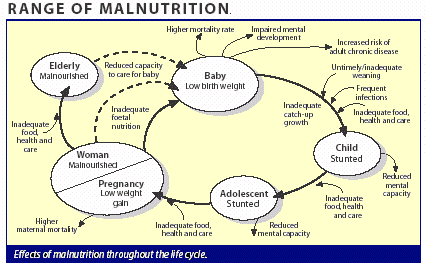Abundance, not
scarcity, best describes the world's food supply. Enough wheat, rice and other
grains are produced to provide every human being with 3,500 calories a day. That
doesn't even count many other commonly eaten foods-vegetables, beans, nuts, root
crops, fruits, grass-fed meats, and fish. Enough food is available to provide at
least 4.3 pounds of food per person a day worldwide: two and half pounds of
grain, beans and nuts, about a pound of fruits and vegetables, and nearly
another pound of meat, milk and eggs-enough to make most people fat! The problem
is that many people are too poor to buy readily available food.
Food is always
available for those who can afford it—starvation during hard times hits only the
poorest. Millions live on the brink of disaster in south Asia, Africa and
elsewhere, because they are deprived of land by a powerful few, trapped in the
unremitting grip of debt, or miserably paid.
Hunger Glossary:
nutrition-related terms and definitions
-
Hunger
is the body's way of signaling that it is running short of food and needs to
eat something. Hunger can lead to malnutrition
-
Undernourishment: describes the status of people whose food intake does
not include enough calories (energy) to meet minimum physiological needs.The
term is a measure of a country's ability to gain access to food and is
normally derived from Food Balance Sheets prepared by the UN Food and
Agriculture Organization (FAO)
-
Malnutrition/
Undernutrition:
defined as a state in which the physical function of an individual is
impaired to the point where he or she can no longer maintain natural bodily
capacities such as growth, pregnancy, lactation, learning abilities,
physical work and resisting and recovering from disease.The term covers a
range of problems from being dangerously thin (see Underweight) or too short
(see Stunting) for one's age to being deficient in vitamins and minerals or
being too fat (obese). Malnutrition is measured not by how much food is
eaten but by physical measurements of the body - weight or height - and age
(see Stunting, Wasting, Underweight)
-
Stunting:
reflects shortness-for-age; an indicator of chronic malnutrition and
calculated by comparing the height-for-age of a child with a reference
population of well nourished and healthy children. According to the Food and
Agriculture Organization's 2004 report on Food Insecurity, almost one third
of all children are stunted
-
Wasting:
reflects a recent and severe process that has led to substantial weight
loss, usually associated with starvation and/or disease. Calculated by
comparing weight-for-height of a child with a reference population of well
nourished and healthy children. Often used to assess the severity of
emergencies because it is strongly related to mortality
-
Underweight:
measured by comparing the weight-for-age of a child with a reference
population of well nourished and healthy children.

Hunger Facts
GLOBAL
HUNGER
-
25,000 people
(adults and children) die every day from hunger and related causes;
-
Over 1 Billion
people do not have enough to eat - more than the populations of USA, Canada
and the European Union;
-
The number of
undernourished people in the world increased by 75 million in 2007 and 40
million, largely due to higher food prices;
-
907 million
people in developing countries alone are hungry;
-
Asia and the
Pacific region is home to over half the world’s population and nearly two
thirds of the world’s hungry people;
-
More than 60
percent of chronically hungry people are women;
-
65 percent of
the world's hungry live in only seven countries: India, China, the
Democratic Republic of Congo, Bangladesh, Indonesia, Pakistan and Ethiopia.
CHILD HUNGER
CHILD HUNGER
-
Every six
seconds a child dies because of hunger and related causes;
-
More than 70
percent of the world's 146 million underweight children under age five years
live in just 10 countries, with more than 50 per cent located in South Asia
alone;
-
10.9 million
children under five die in developing countries each year. Malnutrition and
hunger-related diseases cause 60 percent of the deaths;
-
The cost of
undernutrition to national economic development is estimated at US$20-30
billion per annum;
-
One out of four
children - roughly 146 million - in developing countries are underweight;
-
WFP provided
school meals and/or take home rations to 19.3 million children in 70
countries in 2007;
MALNUTRITION
-
Iodine
deficiency is the greatest single cause of mental retardation and brain
damage. Worldwide, 1.9 billion people are at risk of iodine deficiency,
which can easily be prevented by adding iodine to salt
There is enough food in the world to feed everyone.
Yet, malnutrition and hunger still afflict one out of every seven people on
earth. Why does hunger exist?
NATURE
Natural disasters such as floods, tropical storms and long periods of drought
are on the increase -- with calamitous consequences for food security in poor,
developing countries. Drought is now the single most common cause of food
shortages in the world. In 2006, recurrent drought caused crop failures and
heavy livestock losses in parts of Ethiopia, Somalia and Kenya. In many
countries, climate change is exacerbating already adverse natural conditions.
For example, poor farmers in Ethiopia or Guatemala traditionally deal with rain
failure by selling off livestock to cover their losses and pay for food. But
successive years of drought, increasingly common in the Horn of Africa and
Central America, are exhausting their resources.
WAR
Since 1992, the
proportion of short and long-term food crises that can be attributed to human
causes has more than doubled, rising from 15 percent to more than 35 percent.
All too often, these emergencies are triggered by conflict.
From Asia to Africa
to Latin America, fighting displaces millions of people from their homes,
leading to some of the world's worst hunger emergencies. Since 2004, conflict in
the Darfur region of Sudan has uprooted more than a million people,
precipitating a major food crisis -- in an area that had generally enjoyed good
rains and crops.
In war, food
sometimes becomes a weapon. Soldiers will starve opponents into submission by
seizing or destroying food and livestock and systematically wrecking local
markets. Fields and water wells are often mined or contaminated, forcing farmers
to abandon their land.
When conflict threw
Central Africa into confusion in the 1990s, the proportion of hungry people rose
from 53 percent to 58 percent. By comparision, malnutrition is on the retreat in
more peaceful parts of Africa such as Ghana and Malawi.
POVERTY TRAP
In developing
countries, farmers often cannot afford seed to plant the crops that would
provide for their families. Craftsmen lack the means to pay for the tools to ply
their trade. Others have no land or water or education to lay the foundations
for a secure future.
The poverty-stricken
do not have enough money to buy or produce enough food for themselves and their
families.
In turn, they tend
to be weaker and cannot produce enough to buy more food.
In short, the poor
are hungry and their hunger traps them in poverty.
AGRICULTURAL
INFRASTRUCTURE
In the long-term,
improved agricultural output offers the quickest fix for poverty and hunger.
According to the
Food and Agriculture Organization (FAO) 2004 Food Insecurity Report, all the
countries that are on track to reach the first Millennium Development Goal have
something in common -- significantly better than average agricultural growth.
Yet too many
developing countries lack key agricultural infrastructure, such as enough roads,
warehouses and irrigation. The results are high transport costs, lack of storage
facilities and unreliable water supplies.
All conspire to
limit agricultural yields and access to food.
But, although the majority of developing countries depend on agriculture, their
governments economic planning often emphasises urban development.
OVER-EXPLOITATION
OF ENVIRONMENT
Poor farming
practices, deforestation, overcropping and overgrazing are exhausting the
Earth's fertility and spreading the roots of hunger.
Increasingly, the
world's fertile farmland is under threat from erosion, salination and
desertification.
Just as there is no single cause of hunger, there is no single solution. Aid
organizations around the world try to prevent and alleviate hunger in a variety
of ways, including:
-
Protecting people from famine by giving food to them in emergencies;
-
Reducing poverty by helping poor people find and hold jobs or training them
for jobs where they can make money;
-
Providing information to people about the necessity of a well-balanced diet;
-
Making farming more productive so that there will be more food for the
world’s growing population.
For More
Information Visit The Following Sites By Clicking on The Logo







